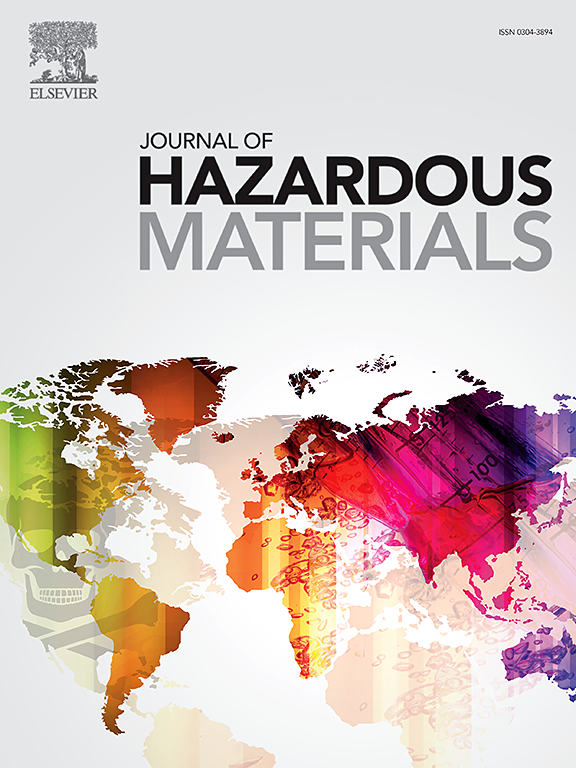机器学习驱动的Co2P/CoP异质结构上Cd(II)和Cu(II)的同步定量:通过活化Co-P电子桥增强电化学信号
IF 11.3
1区 环境科学与生态学
Q1 ENGINEERING, ENVIRONMENTAL
引用次数: 0
摘要
多种重金属离子的同时定量仍然是电化学方法中的一项重大挑战,因为来自信号干扰的复杂高通量数据无法通过单独的专业知识和校准曲线进行准确分析。本研究引入了机器学习技术来共同检测镉(II)和铜(II),并在高活性 Co2P/CoP 异质结构上探索了它们的电化学干扰机制。随机森林(RF)模型初步确定了响应电流中的关键特征变量,随后将其输入卷积神经网络(CNN),以揭示电化学信号与离子浓度之间的关系,Cd(II)和Cu(II)的R2值均为0.996,显示出极佳的可靠性。镉(II)和铜(II)的均方根误差(RMSE)值分别为 0.0177 和 0.0206 μM,表明预测精度很高。实验和理论计算显示,Cu(II) 与 P 位点的结合优于 Cd(II)。从 Co 原子到 P 原子的电子传递增强以及 Cu-P 键的减弱促进了 Cu(II) 从 Co2P/CoP 的还原和解吸,从而提高了电化学信号,而 Cd(II) 信号则由于活性位点的丧失而受到抑制。在这里,机器学习的集成为同时检测多种分析物提供了有力支持,从而加快了电化学方法在环境监测中的实际应用。本文章由计算机程序翻译,如有差异,请以英文原文为准。

Machine learning-driven simultaneous quantification of Cd(II) and Cu(II) on Co2P/CoP heterostructure: enhanced electrochemical signals via activated Co-P electron bridge
Simultaneous quantification of multiple heavy metal ions remains a significant challenge in electrochemical methods, as complex high-throughput data from signal interference cannot be accurately analyzed through individual expertise and calibration curves. In this study, machine learning techniques were introduced to co-detect Cd(II) and Cu(II), with their electrochemical interference mechanisms explored on highly active Co2P/CoP heterostructures. The random forest (RF) model initially identified key feature variables in response currents, which were subsequently input into the convolutional neural network (CNN) to uncover the relationship between electrochemical signals and ion concentrations, demonstrating excellent reliability with R2 values of 0.996 for both Cd(II) and Cu(II). The root mean square error (RMSE) values for Cd(II) and Cu(II) were 0.0177 and 0.0206 μM, respectively, indicating high predictive accuracy. The experiments and theory calculations revealed that Cu(II) preferentially bonded with P sites over Cd(II). Enhanced electron transfer from Co to P atoms and weakened Cu-P bonds facilitated Cu(II) reduction and desorption from Co2P/CoP, thereby boosting electrochemical signals, while Cd(II) signals were inhibited due to active site loss. Herein, the integration of machine learning provides robust support for simultaneous detection of multiple analytes, accelerating the practical application of electrochemical methods in environmental monitoring.
求助全文
通过发布文献求助,成功后即可免费获取论文全文。
去求助
来源期刊

Journal of Hazardous Materials
工程技术-工程:环境
CiteScore
25.40
自引率
5.90%
发文量
3059
审稿时长
58 days
期刊介绍:
The Journal of Hazardous Materials serves as a global platform for promoting cutting-edge research in the field of Environmental Science and Engineering. Our publication features a wide range of articles, including full-length research papers, review articles, and perspectives, with the aim of enhancing our understanding of the dangers and risks associated with various materials concerning public health and the environment. It is important to note that the term "environmental contaminants" refers specifically to substances that pose hazardous effects through contamination, while excluding those that do not have such impacts on the environment or human health. Moreover, we emphasize the distinction between wastes and hazardous materials in order to provide further clarity on the scope of the journal. We have a keen interest in exploring specific compounds and microbial agents that have adverse effects on the environment.
 求助内容:
求助内容: 应助结果提醒方式:
应助结果提醒方式:


